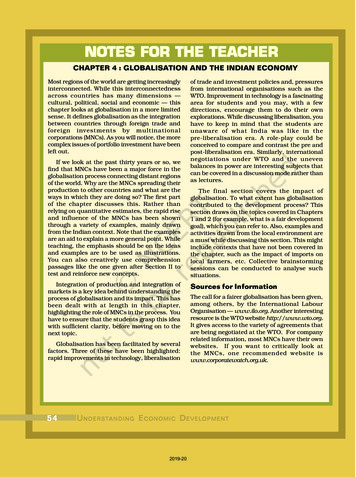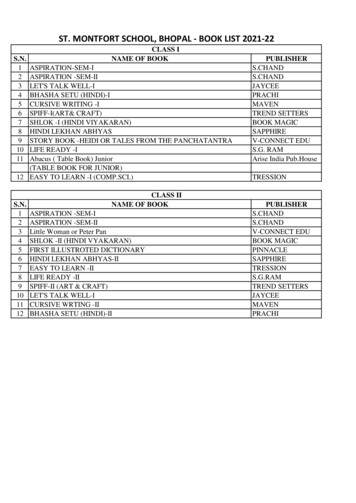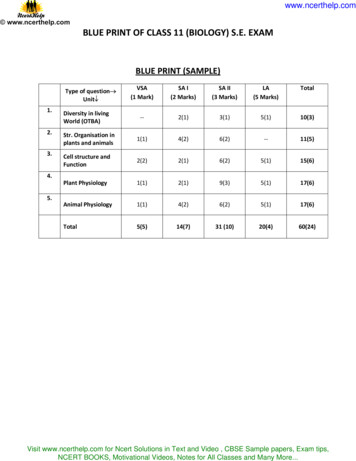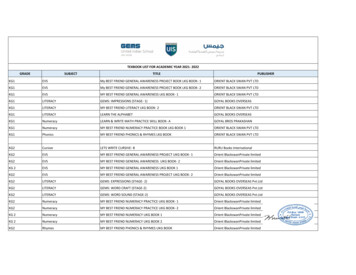
Transcription
Most regions of the world are getting increasinglyinterconnected. While this interconnectednessacross countries has many dimensions —cultural, political, social and economic — thischapter looks at globalisation in a more limitedsense. It defines globalisation as the integrationbetween countries through foreign trade andforeign investments by multinationalcorporations (MNCs). As you will notice, the morecomplex issues of portfolio investment have beenleft out.If we look at the past thirty years or so, wefind that MNCs have been a major force in theglobalisation process connecting distant regionsof the world. Why are the MNCs spreading theirproduction to other countries and what are theways in which they are doing so? The first partof the chapter discusses this. Rather thanrelying on quantitative estimates, the rapid riseand influence of the MNCs has been shownthrough a variety of examples, mainly drawnfrom the Indian context. Note that the examplesare an aid to explain a more general point. Whileteaching, the emphasis should be on the ideasand examples are to be used as illustrations.You can also creatively use comprehensionpassages like the one given after Section II totest and reinforce new concepts.Integration of production and integration ofmarkets is a key idea behind understanding theprocess of globalisation and its impact. This hasbeen dealt with at length in this chapter,highlighting the role of MNCs in the process. Youhave to ensure that the students grasp this ideawith sufficient clarity, before moving on to thenext topic.Globalisation has been facilitated by severalfactors. Three of these have been highlighted:rapid improvements in technology, liberalisation of trade and investment policies and, pressuresfrom international organisations such as theWTO. Improvement in technology is a fascinatingarea for students and you may, with a fewdirections, encourage them to do their ownexplorations. While discussing liberalisation, youhave to keep in mind that the students areunaware of what India was like in thepre-liberalisation era. A role-play could beconceived to compare and contrast the pre andpost-liberalisation era. Similarly, internationalnegotiations under WTO and the unevenbalances in power are interesting subjects thatcan be covered in a discussion mode rather thanas lectures.The final section covers the impact ofglobalisation. To what extent has globalisationcontributed to the development process? Thissection draws on the topics covered in Chapters1 and 2 (for example, what is a fair developmentgoal), which you can refer to. Also, examples andactivities drawn from the local environment area must while discussing this section. This mightinclude contexts that have not been covered inthe chapter, such as the impact of imports onlocal farmers, etc. Collective brainstormingsessions can be conducted to analyse suchsituations. The call for a fairer globalisation has been given,among others, by the International LabourOrganisation — www.ilo.org. Another interestingresource is the WTO website http://www.wto.org.It gives access to the variety of agreements thatare being negotiated at the WTO. For companyrelated information, most MNCs have their ownwebsites. If you want to critically look atthe MNCs, one recommended website iswww.corporatewatch.org.uk. 2019-20
CHAPTER 4 As consumers in today’s world, someof us have a wide choice of goods andservices before us. The latest modelsof digital cameras, mobile phones andtelevisions made by the leadingmanufacturers of the world are withinour reach. Every season, new modelsof automobiles can be seen on Indianroads. Gone are the days whenAmbassador and Fiat were the onlycars on Indian roads. Today, Indiansare buying cars produced by nearlyall the top companies in the world. Asimilar explosion of brands can beseen for many other goods: from shirtsto televisions to processed fruit juices.Such wide-ranging choice of goodsin our markets is a relatively recentphenomenon. You wouldn’t havefound such a wide variety of goods inIndian markets even two decadesback. In a matter of years, ourmarkets have been transformed!How do we understand theserapid transformations? What are thefactors that are bringing about thesechanges? And, how are these changesaffecting the lives of the people?We shall dwell on these questions inthis chapter. 2019-20
Until the middle of the twentiethcentury, production was largelyorganised within countries. Whatcrossed the boundaries of thesecountries were raw material, food stuffand finished products. Colonies suchas India exported raw materials andfood stuff and imported finishedgoods. Trade was the main channelconnecting distant countries. This wasbefore large companies calledmultinational corporations (MNCs)emerged on the scene. A MNC is acompany that owns or controlsproduction in more than one nation.MNCs set up offices and factories forproduction in regions where they canget cheap labour and other resources.This is done so that the cost ofproduction is low and the MNCs canearn greater profits. Consider thefollowing example. A large MNC, producing industrial equipment, designs itsproducts in research centres in the United States, and thenhas the components manufactured in China. These are thenshipped to Mexico and Eastern Europe where the productsare assembled and the finished products are sold all over theworld. Meanwhile, the company’s customer care is carried outthrough call centres located in India.This is a call centre in Bengaluru, equipped with telecom facilities and access tothe Internet to provide information and support to customers abroad. 2019-20
In this example the MNC is not onlyselling its finished products globally,but more important, the goods andservices are produced globally. Asa result, production is organised inincreasingly complex ways. Theproduction process is divided intosmall parts and spread out across theglobe. In the above example, Chinaprovides the advantage of being acheap manufacturing location.Mexico and Eastern Europe are usefulfor their closeness to the marketsin the US and Europe. India hashighly skilled engineers who canunderstand the technical aspects ofproduction. It also has educatedEnglish speaking youth who canprovide customer care services. Andall this probably can mean 50-60 percent cost-savings for the MNC!The advantage of spreading outproduction across the borders to themultinationals can be truly immense.LET’S WORK THIS OUTComplete the following statement to show how the production process in the garmentindustry is spread across countries.The brand tag says ‘Made in Thailand’ but they are not Thai products. We dissectthe manufacturing process and look for the best solution at each step. We aredoing it globally. In making garments, the company may, for example, get cottonfibre from Korea, . In general, MNCs set up productionwhere it is close to the markets; wherethere is skilled and unskilled labouravailable at low costs; and where theavailability of other factors ofproduction is assured. In addition,MNCs might look for governmentpolicies that look after their interests.You will read more about the policieslater in the chapter.At times, MNCs set up productionjointly with some of the localcompanies of these countries. Thebenefit to the local company of suchjoint production is two-fold. First,MNCs can provide money foradditional investments, like buyingnew machines for faster production.Second, MNCs might bring with themthe latest technology for production.Having assured themselves of theseconditions, MNCs set up factories andoffices for production. The money thatis spent to buy assets such as land,building, machines and otherequipment is called investment.Investment made by MNCs is calledforeign investment. Any investmentis made with the hope that theseassets will earn profits. 2019-20
But the most common route forMNC investments is to buy up localcompanies and then to expandproduction. MNCs with huge wealthcan quite easily do so. To take anexample, Cargill Foods, a very largeAmerican MNC, has bought oversmaller Indian companies such asParakh Foods. Parakh Foods hadbuilt a large marketing network invarious parts of India, where its brandwas well-reputed. Also, Parakh Foodshad four oil refineries, whose controlhas now shifted to Cargill. Cargill isnow the largest producer of edible oilin India, with a capacity to make 5million pouches daily!In fact, many of the top MNCshave wealth exceeding the entirebudgets of the developing countrygovernments. With such enormouswealth, imagine the power andinfluence of these MNCs!There’s another way in whichMNCs control production. LargeMNCs in developed countries placeorders for production with smallproducers. Garments, footwear,sports items are examples ofindustries where production iscarried out by a large number ofsmall producers around the world.Women at home in Ludhiana making footballs for large MNCs Jeans produced in developing countries beingsold in USA for Rs 6500 ( 145)The products are supplied to theMNCs, which then sell these undertheir own brand names to thecustomers. These large MNCs havetremendous power to determine price,quality, delivery, and labourconditions for these distantproducers.Thus, we see that there are avariety of ways in which the MNCs arespreading their production andinteracting with local producers invarious countries across the globe. Bysetting up partnerships with localcompanies, by using the localcompanies for supplies, by closelycompeting with the local companiesor buying them up, MNCs are exertinga strong influence on productionat these distant locations. As aresult, production in these widelydispersed locations is gettinginterlinked. 2019-20
LET’S WORK THESE OUTFord Motors, an Americancompany, is one of theworld’s largestautomobile manufacturerswith production spreadover 26 countries of theworld. Ford Motors cameto India in 1995 andspent Rs. 1700 crore toset up a large plant nearChennai. This was donein collaboration withMahindra and Mahindra,a major Indianmanufacturer of jeepsand trucks. By the year2017, Ford Motors wasselling 88,000 cars in theIndian markets,while another 1,81,000cars were exported fromIndia to South Africa,Mexico, Brazil and UnitedStates of America. Thecompany wants todevelop Ford India as acomponent supplyingbase for its other plantsacross the globe.Read the passage on the left and answer the questions.1. Would you say Ford Motors is a MNC? Why?2. What is foreign investment? How much did Ford Motors invest in India?3. By setting up their production plants in India, MNCs such as FordMotors tap the advantage not only of the large markets that countriessuch as India provide, but also the lower costs of production. Explainthe statement.4. Why do you think the company wants to develop India as a base formanufacturing car components for its global operations? Discuss thefollowing factors:(a) cost of labour and other resources in India(b) the presence of several local manufacturers who supply autoparts to Ford Motors(c) closeness to a large number of buyers in India and China5. In what ways will the production of cars by Ford Motors in India lead tointerlinking of production?6. In what ways is a MNC different from other companies?7. Nearly all major multinationals are American, Japanese or European,such as Nike, Coca-Cola, Pepsi, Honda, Nokia. Can you guess why?Cars made by Indian workers beingtransported to be sold abroad by MNCs. For a long time foreign trade has beenthe main channel connectingcountries. In history you would haveread about the trade routesconnecting India and South Asia tomarkets both in the East and Westand the extensive trade that took placealong these routes. Also, you wouldremember that it was trading interestswhich attracted various tradingcompanies such as the East IndiaCompany to India. What then is thebasic function of foreign trade?To put it simply, foreign tradecreates an opportunity for theproducers to reach beyond thedomestic markets, i.e., markets of theirown countries. Producers can sell theirproduce not only in markets locatedwithin the country but can alsocompete in markets located in othercountries of the world. Similarly, for thebuyers, import of goods produced inanother country is one way ofexpanding the choice of goods beyondwhat is domestically produced. 2019-20
adefect of foreign trLet us see the eftoysseneple of Chithrough the examarkets.in the Indian m Chinese manufacturers learnof an opportunity to export toysto India, where toys are sold ata high price. They startexporting plastic toys to India.Buyers in India now have theoption of choosing betweenIndian and the Chinese toys.Because of the cheaper pricesand new designs, Chinese toysbecome more popular in theIndian markets. Within a year,70 to 80 per cent of the toyshops have replaced Indiantoys with Chinese toys. Toysare now cheaper in the Indianmarkets than earlier. What is happening here? As aresult of trade, Chinese toyscome into the Indian markets.In the competition betweenIndian and Chinese toys,Chinese toys prove better.Indian buyers have a greaterchoice of toys and at lowerprices. For the Chinese toymakers, this provides anopportunity to expand business.The opposite is true for Indiantoy makers. They face losses,as their toys are sellingmuch less. 2019-20
In general, with the opening oftrade, goods travel from one marketto another. Choice of goods in themarkets rises. Prices of similar goodsin the two markets tend to becomeequal. And, producers in the twocountries now closely compete againsteach other even though they areseparated by thousands of miles!Foreign trade thus results inconnecting the markets orintegration of markets in differentcountries.Small traders of readymade garments facing stiffcompetition from both the MNC brands and imports.LET’S WORK THESE OUT1. What was the main channel connecting countries in the past? How is it differentnow?2. Distinguish between foreign trade and foreign investment.3. In recent years China has been importing steel from India. Explain how the importof steel by China will affect.(a) steel companies in China.(b) steel companies in India.(c) industries buying steel for production of other industrial goods in China.4. How will the import of steel from India into the Chinese markets lead to integrationof markets for steel in the two countries? Explain. In the past two to three decades, moreand more MNCs have been looking forlocations around the world whichwould be cheap for their production.Foreign investment by MNCs in thesecountries has been rising. At the sametime, foreign trade between countrieshas been rising rapidly. A large partof the foreign trade is also controlledby MNCs. For instance, the carmanufacturing plant of Ford Motorsin India not only produces cars for theIndian markets, it also exports carsto other developing countries andexports car components for its manyfactories around the world. Likewise,activities of most MNCs involvesubstantial trade in goods and alsoservices. 2019-20
The result of greater foreigninvestment and greater foreign tradehas been greater integration ofproduction and markets acrosscountries. Globalisation is thisprocess of rapid integration orinterconnection between countries.MNCs are playing a major role inthe globalisation process. Moreand more goods and services,investments and technology aremoving between countries. Mostregions of the world are in closerLET’S WORK THESE OUTcontact with each other than a fewdecades back.Besides the movements of goods,services, investments and technology,there is one more way in which thecountries can be connected. This isthrough the movement of peoplebetween countries. People usuallymove from one country to another insearch of better income, better jobs orbetter education. In the past fewdecades, however, there has not beenmuch increase in the movement ofpeople between countries due tovarious restrictions.1. What is the role of MNCs in the globalisation process?2. What are the various ways in which countries can belinked?3. Choose the correct option.Globalisation, by connecting countries, shall result in(a) lesser competition among producers.(b) greater competition among producers.(c) no change in competition among producers. Rapid improvement in technology has been one major factor that hasstimulated the globalisation process. For instance, the past fifty years haveseen several improvements in transportation technology. This has made muchfaster delivery of goods across long distances possible at lower costs. Goods are placed in containersthat can be loaded intact ontoships, railways, planes and trucks.Containers have led to hugereduction in port handling costsand increased the speed withwhich exports can reach markets.Similarly, the cost of air transporthas fallen. This has enabled muchgreater volumes of goods beingtransported by airlines. 2019-20
Even more remarkable have beenthe developments in information andcommunication technology. Inrecent times, technology in the areasof telecommunications, computers,Internet has been changing rapidly.Telecommunication facilities (telegraph, telephone including mobilephones, fax) are used to contact oneanother around the world, to accessinformation instantly, and tocommunicate from remote areas. Thishas been facilitated by satellitecommunication devices. As youwould be aware, computers have nowentered almost every field of activity.You might have also ventured into theamazing world of internet, where youcan obtain and share information onalmost anything you want to know.Internet also allows us to send instantelectronic mail (e-mail) and talk(voice-mail) across the world atnegligible costs. n technologyd communicatioInformation anrole ins played a majorhat)orshinITr(orvicesoduction of sespreading out prw.hoes. Let us seacross countrie A news magazine published for Londonreaders is to be designed and printed inDelhi. The text of the magazine is sentthrough Internet to the Delhi office. Thedesigners in the Delhi office getorders on how to design the magazinefrom the office in London usingtelecommunication facilities. Thedesigning is done on a computer. Afterprinting, the magazines are sent by airto London. Even the payment of moneyfor designing and printing from a bankin London to a bank in Delhi is doneinstantly through the Internet(e-banking)!LET’S WORK THESE OUT 1. In the above example, underline thewords describing the use oftechnology in production. 2. How is information technologyconnected with globalisation? Wouldglobalisation have been possiblewithout expansion of IT? 2019-20
Let us return to the example of importsof Chinese toys in India. Suppose theIndian government puts a tax onimport of toys. What would happen?Those who wish to import these toyswould have to pay tax on this. Becauseof the tax, buyers will have to pay ahigher price on imported toys. Chinesetoys will no longer be as cheap in theIndian markets and imports fromChina will automatically reduce.Indian toy-makers will prosper.Tax on imports is an example oftrade barrier. It is called a barrierbecause some restriction has been setup. Governments can use tradebarriers to increase or decrease(regulate) foreign trade and to decidewhat kinds of goods and how muchof each, should come into the country.The Indian government, afterIndependence, had put barriers toforeign trade and foreign investment.This was considered necessary toprotect the producers within thecountry from foreign competition.Industries were just coming up in the1950s and 1960s, and competitionfrom imports at that stage would nothave allowed these industries to comeup. Thus, India allowed importsof only essential items such asmachinery, fertilisers, petroleumetc. Note that all developedcountries, during the early stages ofdevelopment, have given protection todomestic producers through a varietyof means.Starting around 1991, some farreaching changes in policy were madein India. The government decided thatthe time had come for Indianproducers to compete with producersaround the globe. It felt thatcompetition would improve theperformance of producers within thecountry since they would have toimprove their quality. This decisionwas supported by powerfulinternational organisations.Thus, barriers on foreign trade andforeign investment were removed to alarge extent. This meant that goodscould be imported and exportedeasily and also foreign companiescould set up factories and officeshere.Removing barriers or restrictionsset by the government is what isknown as liberalisation. Withliberalisation of trade, businesses areallowed to make decisions freelyabout what they wish to import orexport. The government imposesmuch less restrictions than beforeand is therefore said to be moreliberal.LET’S WORK THESE OUT1. What do you understand by liberalisation of foreign trade?2. Tax on imports is one type of trade barrier. The government could also place a limit onthe number of goods that can be imported. This is known as quotas. Can you explain,using the example of Chinese toys, how quotas can be used as trade barriers?Do you think this should be used? Discuss. 2019-20
We have seen that the liberalisationof foreign trade and investment inIndia was supported by some verypowerful international organisations.These organisations say that allbarriers to foreign trade andinvestment are harmful. Thereshould be no barriers. T radebetween countries should be ‘free’.All countries in the world shouldliberalise their policies.World Trade Organisation (WTO) isone such organisation whose aim isto liberalise international trade.Started at the initiative of thedeveloped countries, WTO establishesrules regarding international trade,and sees that these rules are obeyed.At present 164 countries of the worldare currently members of the WTO.Though WTO is supposed to allowfree trade for all, in practice, it is seenthat the developed countries haveunfairly retained trade barriers. Onthe other hand, WTO rules have forcedthe developing countries to removetrade barriers. An example of this isthe current debate on trade inagricultural products. Developing countries are, therefore, asking theYou have seen in Chapter 2, thatdeveloped country gover nments, “We havethe agriculture sector provides thereducedtrade barriers as per WTO rules. But youbulk of employment and ahave ignored the rules of WTO and havesignificant portion of the GDP incontinued to pay your farmers vast sums ofIndia. Compare this to a developedmoney. You have asked our governments to stopcountry such as the US with thesupporting our farmers, but you are doing soshare of agriculture in GDP at 1%yourselves. Is this free and fair trade?”and its share in total employmenta tiny 0.5%! And yet this verysmall percentage of peoplewhoareengagedin A typical cotton farm in USA consists of thousands of acres owned bya huge corporation that will sell cotton abroad at lowered prices.agriculture in the US receivemassive sums of money fromthe US gover nment forproduction and for exports toother countries. Due to thismassive money that theyreceive, US farmers can sellthe far m products atabnormally low prices. Thesurplus farm products aresold in other country marketsat low prices, adverselyaffecting farmers in thesecountries. 2019-20
LET’S WORK THESE OUT1. Fill in the blanks.WTO was started at the initiative of countries. The aim of the WTO is to. WTO establishes rules regarding forall countries, and sees that In practice, trade between countriesis not . Developing countries like India have, whereas developed countries, in many cases, have continuedto provide protection to their producers.2. What do you think can be done so that trade between countries is more fair?3. In the above example, we saw that the US government gives massive sums of moneyto farmers for production. At times, governments also give support to promote productionof certain types of goods, such as those which are environmentally friendly. Discusswhether these are fair or not. In the last twenty years, globalisationof the Indian economy has come along way. What has been its effect onthe lives of people? Let us look atsome of the evidence.Globalisation and greatercompetition among producers - bothlocal and foreign producers - has beenof advantage to consumers,particularly the well-off sections in theurban areas. There is greater choicebefore these consumers who nowenjoy improved quality and lowerprices for several products. As a result,these people today, enjoy muchhigher standards of living than waspossible earlier.2019-20Among producers and workers,the impact of globalisation has notbeen uniform.Firstly, MNCs have increased theirinvestments in India over the past 20years, which means investing in Indiahas been beneficial for them. MNCshave been interested in industriessuch as cell phones, automobiles,electronics, soft drinks, fast food orservices such as banking in urbanareas. These products have a largenumber of well-off buyers. In theseindustries and services, new jobs havebeen created. Also, local companiessupplying raw materials, etc. to theseindustries have prospered.
In recent years, the central and stategovernments in India are taking specialsteps to attract foreign companies toinvest in India. Industrial zones, calledSpecial Economic Zones (SEZs), arebeing set up. SEZs are to have world classfacilities: electricity, water, roads,transport, storage, recreational andeducational facilities. Companies who setup production units in the SEZs do nothave to pay taxes for an initial period offive years.rights. In the recent years, the governmenthas allowed companies to ignore many ofthese. Instead of hiring workers on aregular basis, companies hire workers‘flexibly’ for short periods when there isintense pressure of work. This is done toreduce the cost of labour for the company.However, still not satisfied, foreigncompanies are demanding more flexibilityin labour laws. Government has also allowedflexibility in the labour laws to attractforeign investment. You have seen inChapter 2 that the companies in theorganised sector have to obey certainrules that aim to protect the workers’Secondly, several of the top Indiancompanies have been able to benefitfrom the increased competition. Theyhave invested in newer technology andproduction methods and raised theirproduction standards. Some havegained from successful collaborationswith foreign companies.Moreover, globalisation hasenabled some large Indian companiesto emerge as multinationalsthemselves! Tata Motors (automobiles), Infosys (IT), Ranbaxy(medicines), Asian Paints (paints),Sundaram Fasteners (nuts and bolts)are some Indian companies whichare spreading their operationsworldwide.Globalisation has also creatednew opportunities for companiesproviding services, particularly thoseinvolving IT. The Indian companyproducing a magazine for the Londonbased company and call centres aresome examples. Besides, a host ofservices such as data entry, accounting, administrative tasks, engineeringare now being done cheaply incountries such as India and areexported to the developed countries.LET’S WORK THESE OUT1. How has competition benefited people in India?2. Should more Indian companies emerge as MNCs? How would it benefit the people inthe country?3. Why do governments try to attract more foreign investment?4. In Chapter 1, we saw what may be development for one may be destructive for others.The setting of SEZs has been opposed by some people in India. Find out who arethese people and why are they opposing it. 2019-20
For a large number of small producers andworkers globalisation has posed majorchallenges. Ravi did not expect that he would haveto face a crisis in such a short periodof his life as industrialist. Ravi took aloan from the bank to starthis owncompany producing capacitorsin 1992in Hosur, an industrial townin TamilNadu. Capacitors are usedin manyelectronic home a
had four oil refineries, whose control has now shifted to Cargill. Cargill is now the largest producer of edible oil in India, with a capacity to make 5 million pouches daily! In fact, many of the top MNCs have wealth exceeding the entire budgets of the developing country governments. With such enormous wealth, imagine the power and influence .











